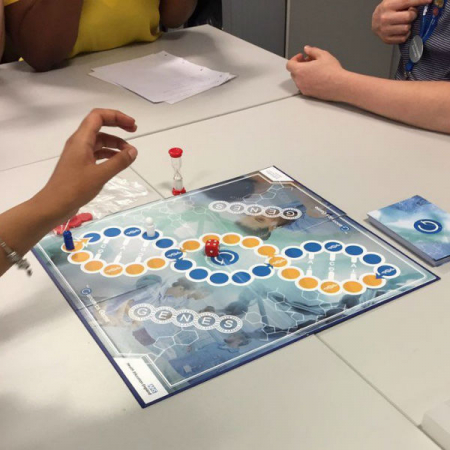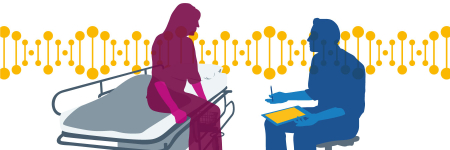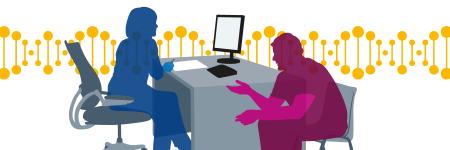Introduction
Rapid advances in technology and understanding mean that genomic testing is becoming much more integral to the practice of all neurologists. Given such advances, and the introduction of the national Genomic Medicine Service in England, there is a requirement to consider where genomics may benefit our patients and be familiar with the testing process and the implications for patients and families.
In this film, Professor Huw Morris of UCL, UCLH and Royal Free Hospital outlines the ways in which genomics is increasingly being applied in the clinic, and some of the things that all neurologists should be aware of.
What do I need to know?
Why is genomics important in neurology?
Genomics refers to the study of all of an individual’s DNA. Our knowledge in this area is advancing rapidly thanks to new genomic technologies.
Understanding the control of gene expression in the brain is central to understanding normal brain function, and increasingly neurological disease.
Genomic testing and the information it generates underpin diagnosis, treatment and management decisions for some neurological diseases, and in the future this is will become the case for common conditions as well as well-known neurogenetic diseases.
The introduction of the NHS Genomic Medicine Service in England means all neurologists will have access to genomic testing where they may not have done previously; thus, understanding all the instances where this could benefit our patients is important.
As genomic technology is enabling progress in our understanding of the aetiology of disease, it is enabling the development of new targeted therapies. Rapid progress in clinical trials and drug development are expected over the next few years. There are now trails underway for Parkinson’s disease and motor neurone disease, for example, targeting specific genes such as LRRK2 and C9orf72 (see ‘Genomics in Practice’ examples below).
How is genomics used in neurology?
Diagnosis
Genomic testing is particularly useful in the diagnosis of familial and early-onset neurodegenerative diseases, for example ataxia, hereditary spastic paraparesis and some forms of dementia and Parkinson’s.
Prior to genomic technologies, testing was done gene by gene. For a condition where there may, for example, be 10 possible genetic causes, this is a time-consuming process which takes its toll on patients and families. Genomic testing enables us to test many genes concurrently and thus speeds up diagnosis in these instances.
Predictive testing
Genomic test results can impact whole families. If one person in a family is found to have pathogenic variants, other family members could, too. If such variants are found early, it can enable better clinical management for the whole family and enable individuals to consider their options for the future. For example, identification of the Huntington’s gene mutation in a family with Huntington disease enables the counselling of other family members for risk-management including possible predictive testing and referral to relevant clinical trials.
Targeted treatment
In some instances, a precise genetic diagnosis means an individual can access gene-directed therapies which have a good chance of benefiting them. In this film, professor Morris talks about the treatment of spinal muscular atrophy (SMA) with Nusinersin. It is hoped that other gene-directed therapies will soon be available.
Clinical trails and drug development
The identification of the genetic cause(s) of a disease makes it easier to develop targeted therapies. For example:
- The identification of mutations in the synuclein gene in Parkinson’s disease, and identifications and mutations in the APP and presenilin genes in Alzheimer’s disease, have allowed for the development of animal models. These animal models have been used to develop antibody-based treatments for these diseases, and those antibody treatments are now in clinical trials. Updates can be found on the Alzoforum website.
- Several years ago, the gene most commonly associated with motor neurone disease – the C9orf72 gene – was identified. A gene therapy trial is now in progress, looking to turn off the abnormal gene and potentially provide a treatment for affected patients (see ‘Genomics in Practice’ example below).
The widespread availability and relative accessibility of genomic testing will result in more trials, more patients being eligible for and recruited to trials, and, as a result, more rapid progress in the area of targeted treatments.
Polygenic risk scores
We know that some people are at higher risk of certain conditions due to a combination of multiple genetic variants – for example Parkinson’s Disease, for which we know of around 90 associated areas of the genome. Estimating this risk to an individual using polygenic risk scores is complex, but it is a focus for research. Genomic technologies make rapid advances in this area probable, but it is likely that clinical geneticists will specialise in this area.
How can I play my part?
Now that we have access to genomic testing through the NHS Genomic Medicine Service, it’s important to understand:
- The ways in which genomic information can be used to help patients – for example: in diagnosis and family management; getting access to targeted treatments; making reproductive choices.
- The cases in which genomics could be relevant; and it’s important to understand that genomics can be relevant when managing common conditions as well as the classical neurogenetic diseases like HSP, Huntington’s disease, and Charcot-Marie-Tooth disease.
- The kind of genomic tests available and how to order such tests (as well as who to turn to in your organisation for further guidance when necessary).
- The important considerations for patients and families considering or undergoing genomic testing, so that these can be clearly communicated (see counselling below).
- The value of collaboration. The amount and type of data generated by genomic testing may often benefit from being analysed by both experts in genomics and neurologists with a deep understanding of the phenotype.
- What the genomic test report looks like and its possible implications (eg the types of results and potential actions that can be taken).
- When it is appropriate to hand over to other professionals – such as in complex undiagnosed cases, or for prenatal testing and diagnosis, which should be handled by clinical geneticists and genetic counsellors.
It will also be important to stay abreast of developments in the Genomic Medicine Service, which is a new service that will rapidly evolve.
More and more clinical trials are opening up for patients, so these should also be considered.
Counselling
Now that testing is opening up and we will be offering it directly to our patients more and more, Professor Morris recommends being aware of the following key counselling considerations. It’s important to be certain that the patient and their family, if they’re present, understand their options and the potential implications of genomic tests.
- The possibility of no diagnosis.
- The idea of penetrance – that not all individuals who carry a gene variant will develop the disease, and some people will develop the disease in later life.
- The possibility of additional findings – where something about the individual’s genome that is unrelated to the original clinical question, but deemed important for their future health, is found. We now have a list of genes that can be looked at, where we think an intervention might help the patient, which is continuously being reviewed. Patients and families have choices about what may be looked at.
- If relevant, what targeted treatment involves.
- The concept of ‘cascade testing’, if relevant to the patient and family members. When we know the genomic cause of the disease and whether it’s autosomal dominant, recessive, or X-linked, we can give much more precise advice about the risks to other family members. Understanding when it is appropriate to offer predictive testing is important.
- Where patients and families may be able to find further support.
Case example: Gene-directed therapy
As Professor Morris describes in our film, the best example of gene-directed therapy in neurology currently is the use of Nusinersin for children with spinal muscular atrophy (SMA).
- SMA is a rare, severely life-limiting and ultimately fatal neuromuscular condition which causes most affected children to die from respiratory failure within the first three years of life.
- Until 2016, there was no treatment for SMA and management in severe cases was with palliative care.
- SMA is caused by mutations in the SMN gene, leading to loss of the SMN1 protein.
- In 2016, the therapy Nusinersin was introduced. Nusinersin works by upregulating a ‘back-up’ copy of the gene, SMN2.
- As a result of the availability of this therapy, children with a diagnosis who previously would have had a very limited life expectancy are able to lead much more normal lives.
- Although the long term effects of the treatment are not known, it is clear that it has a dramatic effect on both quality of life and life expectancy for affected children.
It is hoped that many more treatments, based on similar mechanisms, will be developed now that wider access to genomic technology and genomic data is possible.
Case example: Trial to clinic
In some cases where gene-directed therapies are not available, the wider availability of genomic testing means that patients could be eligible for clinical trials.
- A man, aged 55, is diagnosed with motor neurone disease.
- As he has a strong family history of motor neurone disease, he is tested for the associated C9orf72 gene variant, the commonest cause.
- He has a positive gene test with an hexanucleotide expansion of > 200 repeat units.
- He is referred by his neurologist to a phase1 study of an antisense oligonucleotide therapy for motor neurone disease.
- His family is referred for genetic counselling to consider their long-term management.
For updates on clinical trails, see the Alzoforum website.
In the Clinic: GeNotes Neurology
Try GeNotes (genomic notes for clinicians), our scenario-based resource, providing quick, concise information to support you when ordering genomic tests and returning back results.
Learning opportunities
Teaching aids
Clinical resources
Identifying patients
Activity: Taking and drawing a genetic family history
Equip yourself with the knowledge and skills to construct a genetic pedigree.
Activity: Recognising the clinical clues of a genetic condition
Familiarise yourself with the clinical features of a range of genetic conditions










